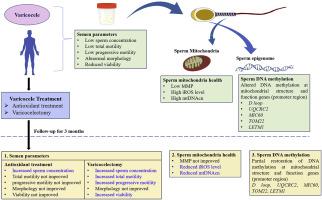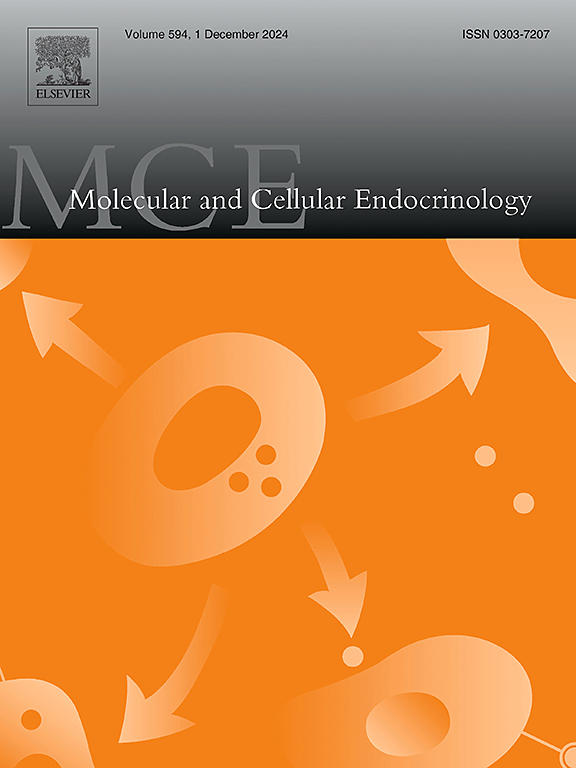临床精索静脉曲张不育男性精子线粒体功能和 DNA 甲基化治疗前后的状况。
IF 3.8
3区 医学
Q2 CELL BIOLOGY
引用次数: 0
摘要
精索静脉曲张与男性生育能力下降有关。精索静脉曲张的治疗方法可改善精液参数,但仍有 50%以上的病例无法生育。精索静脉曲张诱发的热和缺氧应激可能会影响精子线粒体的功能,从而可能导致异常的表观遗传修饰。这项研究包括 30 名可育男性和 40 名患有临床精索静脉曲张的不育男性。治疗 3 个月后,对精索静脉曲张治疗(补充抗氧化剂和或进行精索静脉曲张切除术)的效果进行了评估。线粒体膜电位(MMP)和细胞内活性氧(iROS)分别通过使用 JC-1 和 DCFDA 的流式细胞术进行测量。DNA甲基化采用热测序法进行分析。目前的研究表明,患有精索静脉曲张的不育男性精液参数异常;MMP明显偏低,iROS偏高,mtDNA拷贝数偏高。两种治疗方法都能改善部分男性的精液参数;但与抗氧化剂治疗相比,精索静脉曲张切除术更有助于改善精子参数。两种治疗方法都有助于显著降低iROS和mtDNA拷贝数,但对改善MMP无效。在精索静脉曲张组中,线粒体 D 环和线粒体结构与功能基因 UQCRC2、MIC60、TOM22 和 LETM1(启动子区域)的 DNA 甲基化发生了改变。精索静脉曲张治疗后,DNA 甲基化水平得到了恢复,但并非所有 CpG 位点的甲基化水平都得到了恢复。两种治疗方式都有助于恢复线粒体基因已改变的 DNA 甲基化水平,但在所研究的 CpG 位点上,恢复情况并不一致。本文章由计算机程序翻译,如有差异,请以英文原文为准。

Status of sperm mitochondrial functions and DNA methylation in infertile men with clinical varicocele before and after treatment
Varicocele has been associated with reduced male fertility potential. Treatment modalities for varicocele improve semen parameters, yet more than 50% of cases remain infertile. Varicocele-induced heat and hypoxia stress may affect sperm mitochondrial functions, possibly leading to aberrant epigenetic modifications. This study includes 30 fertile men and 40 infertile men with clinical varicocele. The effect of varicocele treatment (antioxidant supplementation and or varicocelectomy) was evaluated after 3 months of treatment. Mitochondrial membrane potential (MMP) and intracellular reactive oxygen species (iROS) were measured by flow cytometry using JC-1 and DCFDA, respectively. mtDNA copy number and deletions were determined by PCR. DNA methylation was analysed by pyrosequencing. Present investigations suggest that infertile men with varicocele have abnormal semen parameters; significantly low MMP, high iROS, and high mtDNA copy number. Semen parameters were improved in a subset of men of both the treatment modalities; however, it was noted that varicocelectomy helped better in improving sperm parameters compared to antioxidant treatment. Both treatment modalities helped in reducing iROS and mtDNA copy number significantly; however, they were noneffective in improving MMP. Altered DNA methylation at mitochondria D loop and mitochondrial structure and function genes UQCRC2, MIC60, TOM22, and LETM1 (promoter region) were observed in varicocele group. The DNA methylation levels were restored after varicocele treatment; however, the restoration was not consistent at all CpG sites. Both the treatment modalities helped in restoring the altered DNA methylation levels of mitochondrial genes but the restoration is nonhomogeneous across the studied CpG sites.
求助全文
通过发布文献求助,成功后即可免费获取论文全文。
去求助
来源期刊

Molecular and Cellular Endocrinology
医学-内分泌学与代谢
CiteScore
9.00
自引率
2.40%
发文量
174
审稿时长
42 days
期刊介绍:
Molecular and Cellular Endocrinology was established in 1974 to meet the demand for integrated publication on all aspects related to the genetic and biochemical effects, synthesis and secretions of extracellular signals (hormones, neurotransmitters, etc.) and to the understanding of cellular regulatory mechanisms involved in hormonal control.
 求助内容:
求助内容: 应助结果提醒方式:
应助结果提醒方式:


